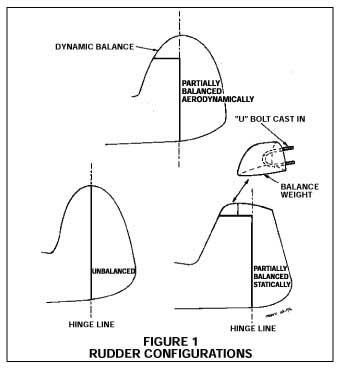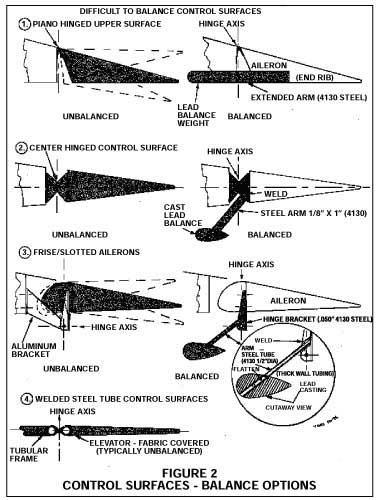Control Surface Balancing in Homebuilts
By Tony Bingelis (originally published in EAA Sport Aviation, December 1996)
The obvious question comes to mind. Why balance control surfaces? Do they really need to be balanced?
Well, much seems to depend on the original design and construction of the control surfaces. Well-designed, rigid structures with little or no play in the hinges, control linkages, and trim tabs are less likely to be susceptible to flutter, hence, may not need to be statically balanced.
Maybe I should attempt to define "flutter" before we continue.
Flutter may be described as an unwanted spontaneous unstable divergent oscillation that may occur in flight . . . in the wing or in any of the control surfaces. It can be brought on by a momentary disturbance and sustained by the aerodynamic, inertial, and structural characteristics of the component itself. Flutter, if unchecked immediately, could result in the failure and often the disintegration of the affected control surface.
The aircraft components most susceptible to flutter are the ailerons and the elevators, and to a lesser degree, the rudder.
Flutter may initially manifest itself, as airspeed increases, as a nibble in the control stick but can intensify so rapidly and to such a degree that structural destruction can take place before the pilot is able to initiate any kind of corrective action.
For the average builder, then, that immediately raises a very important question. Must all movable control surfaces - surfaces like the ailerons, elevators or stabilator, and the rudder - be balanced?
Unfortunately, there is no simple yes or no answer to the question.
If static balancing is required for your particular aircraft design (assuming you are building from plans or from a kit), it is extremely important that you do so.
Does that imply some homebuilt designs do not need to have any of the control surfaces balanced? Yes, that is an established fact!
Many older homebuilts did not/do not require that any of the control surfaces be balanced. In the early 1930s, for example, only 24% of the aircraft provided for the balancing of the elevators. Of course, for the most part, these were comparatively slow aircraft with fabric covered control surfaces.
I’m sure you have heard of or have on occasion seen versions representative of these early designs in homebuilts like the Pitts biplanes, Pietenpols, Fly Babies, Flaglor Scooters, Jodels and Boredom Fighters, to name a few. None of them have balanced control surfaces.
However, this does not mean that you, as a builder of an aircraft of that type, need not be concerned if the plans show no mass balance weights for the control surfaces. You can only assume that the designer did not experience flutter in his particular prototype, hence, saw no reason to indicate otherwise in his plans.
However, most certainly, the aircraft you are building will differ slightly from the designer’s prototype and flutter, in one or more of your control surfaces, is always a possibility. You should, therefore, never assume your own aircraft will likewise be immune from potentially destructive flutter until you have flight tested it through its entire operational range.
Some years ago, one of the early homebuilt designs, a prototype, a simple 75 mph homebuilt, experienced wing/aileron flutter because its wing lacked sufficient rigidity against the twisting forces encountered whenever the ailerons were deflected. Fortunately, the test pilot was alert and the wing/ailerons tendency to flutter was detected before structural damage could occur.
NOTE: Engineers were well aware of this type of problem as early as the 1930s because it was sometimes encountered in internally braced fabric covered monoplane wings. They found that some wing structures had the tendency to vibrate rapidly at fairly large amplitudes at certain speeds. It was evident that this flutter was closely associated with the torsional rigidity of the wing structure. The cure, they learned in each instance, was to stiffen the wing structure, either by adding suitable drag bracing or by substituting plywood skin for the ordinary fabric covering.
And so it was with this particular homebuilt. The prototype was immediately modified by adding a section of plywood skin to the upper inboard wing surface to stiffen it, and just to be sure, lead balance weights were attached to the aileron tips.
Balanced Controls in General
Ailerons seem to be more susceptible to flutter than either elevators or rudders. This becomes evident when you learn that a number of homebuilt designs having somewhat higher performance levels require only that their ailerons be statically balance. In this category of homebuilts are the Emeraudes, Sonerais, and similar aircraft generally with cruise speeds in the 100 mph to 145 mph range.
However, as you get up into the higher performance aircraft, you will find they will have balanced elevators as well, almost without exception. Sometimes, too, a designer will attempt to at least partially balance the rudder. However, it will rarely be balanced 100%.
Years ago, I believed stabilators had to be 100% mass balanced and this assumption applied, too, to most stabilator equipped homebuilt aircraft like the T-18, the Turner T-40 and even the slower VP-1. However, I was surprised to learn later that as early as 1965 John Thorp, designer of the popular T-18, wrote the following answer to a builder’s question:
"Should the horizontal tail balance (T-18) weight be adjusted for perfect static balance?"
His answer was:
"No. The horizontal tail balance weight is a dynamic longitudinal stability augmenter. it reduces static longitudinal stability and provides proper feel forces to the stick in pitch. In smooth air the T-18 will fly better without the bob weight. In any case, its weight is not critical and static balance is not required (or desired)." However, several years later (about 1969) after completing an extensive test program on the T-18, he concluded the balance weight was needed for good stick feel and had to put the weights back on.
Here again, I would emphasize that you as a builder keep in touch with the latest design changes and, remember, assumptions can never take the place of the actual flight testing for each aircraft built from plans.
Flutter Precaution Basics
- The main structure (wing, stabilizer, fin) should have the rigidity and sufficient strength to carry the concentrated loads from the attached ailerons, elevators/stabilator and rudder hinges.
- Guard against adding extra weight aft of the control surface’s hinge line during construction (trim mechanism, reinforcements, heavier materials, etc.).
- Avoid adding those extra coats of finish paint to your control surfaces.
- Your control surfaces hinges should have no play (slop) in them.
- Strive to eliminate all play in your control system rod end bearings and linkages.
- Trim tabs should have virtually no play in the linkage.
- Control surfaces that require balancing must be balanced to the degree recommended. Ordinarily, overbalancing is not detrimental whereas underbalancing could be dangerous.
Incidentally, I know of no homebuilt that has to have its flaps statically balanced - so, don’t worry about that problem as it is no problem at all.
Balancing Control Surfaces
1. How do you avoid the occurrence of flutter in a new untested aircraft?
The best preventative measure a builder can take is to properly mass balance the control surfaces, if necessary, by adding weight (lead, usually) ahead of the hinge line.
It is difficult to mass balance a control surface without adding considerable weight to the completed assembly. The reason for this is because of the control surface’s relatively small area forward of the hinge line that is available for adding the weight needed to balance the control surface. This space ahead of the hinge line often represents a mere 8 to 10% of the total control surface area. Consequently, you would have to add a lot of lead weight forward of the hinge line to cause the structure aft of the hinge line to rise to a level (100% balance) attitude.
The amount of lead weight needed to balance a control surface can be reduced if it can be mounted on an arm that extends well ahead of the hinge axis.
When a control surface is moved to a horizontal attitude and it will stay there, the control surface is said to be totally statically balanced (100% balanced) around its hinge line.
The control surfaces most difficult to balance (assuming they need balancing) are those where the control surface hinges are attached directly to the leading edge of the control surface. Many ailerons are attached in this manner using piano hinges.
On the other hand, elevators and rudders may be similarly hinged. More often, though, elevators and rudders are hinged along their centerlines with individual steel hinges. Nevertheless, all of these installations make it impossible to add counter balance weights ahead of the hinge line without adding to special arms to hold the balance weights ahead of the hinge axis.
Making Lead Balance Weights
A simple and most practical way to melt lead is in a large steel ladle using a butane/propane torch to apply the heat. Drop pieces of lead into the ladle and direct the flame onto the lead. When it becomes molten use a large screwdriver to skim off the slag. Then, pour the molten lead into your aluminum balance mold, balance arm tube or whatever, and allow it to cool.
An economical source of scrap lead may be one of your local tire shops. The removed old lead weights used to balance tires are often scattered all over the work area floor and may be yours to pick up for the asking.
Don’t worry about the steel parts. These can be easily scooped out of your molten lead soup and be allowed to fall on the ground . . . keep your feet out of the way.
Drilling the attachment bolt holes in your lead balance weights can be aggravating. Lead is difficult to drill and the bit will tend to "hog in" and jam. Take it slowly and be patient.
Bolting lead balance weights directly to the support arms can lead to future problems. Because the lead is soft, vibration and occasional less than good landings as well as taxiing over rough areas, can in time cause the bolt attachment holes to elongate and loosen. It is better, therefore, to devise some sort of enclosure or metal restraint for attaching the weights.
In Summary
If your plans call for the control surfaces to be balanced, by all means do so as specified. However, this is no guarantee that your homebuilt will be flutter free.
Likewise, if the claim is made that the control surfaces do not need to be balanced, do not assume that your airplane will also be flutter free until you have flight tested it through its entire operational range.



